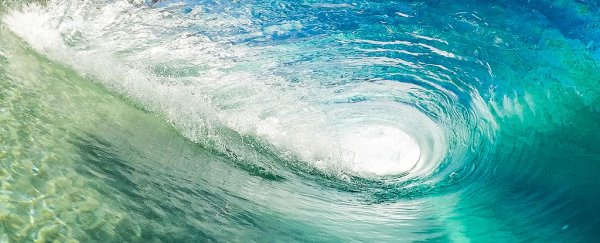Chlorides (respectively all halogens) are always corrosive; the more so, the softer the water.
At a chloride concentration of more than 10 ppm, the corrosion rate of carbon steel drops with increasing HCO3-concentration (Chloride Concentration (ppm)) according to Eq. (14.6): { Johann Friedrich Gülich-Centrifugal Pumps-Springer}
Ccor [mm/year] = 60 – 0.45 c(HCO3) [ppm] (14.6)

Chloride Concentration in Seawater
Sea water typically contains 3.5% (mass) dissolved salts, dominantly sodium and magnesium chlorides (fraction of NaCl 70 to 80%). The O2 content of sea water at 10 to 15 °C is between 10 and 8 ppm (at saturation); the pH is 7.5 to 8.5. { Johann Friedrich Gülich-Centrifugal Pumps-Springer}
Austenitic steels without molybdenum (1.4308, AISI type 304) are resistant against crevice corrosion in cold water (< 25°C) up to a chloride concentration of 200 ppm, while austenitic steels alloyed with molybdenum (1.4409, AISI type 316) can be used up to about 1000 ppm chloride content. { Johann Friedrich Gülich-Centrifugal Pumps-Springer}
Chloride-induced SCC can be avoided by selecting duplex steels or nickel alloys containing more than 25% nickel, refer to Fig. 14.6. { Johann Friedrich Gülich-Centrifugal Pumps-Springer}
14.4.1 Definition of frequently encountered fluids
As mentioned above the exact water analysis of each individual application needs to be known in order to enable a judicious choice of the materials to be used. In Tables 14.6 and 14.12, application limits of various materials are given for typical water qualities which are defined by “W1” to “W6”:
W1: Weakly corrosive water comprising:
- Water with pH above the limit given by Eqs. (14.3 and 14.4) where CO2 is in equilibrium with carbonates
- Waters which is able to form protective films on carbon steel; according to
DIN 50 930 this is water with:
O2 > 3 ppm (not below 2 ppm)
7 < pH < 8.5 (but as high as possible)
c(Ca++) > 0.5 mol/m3 (= mmol/l) respectively °dH > 2.8
Chlorides: Cl < 2 ppm
W2: Surface water and sewage:
Natural water such as fresh water from lakes, rivers or rain usually contains chloride ions in concentrations which can vary in a wide range (10 to 250 ppm).
W3: Sea water without H2S or without O2:
All applications with chloride concentrations above 1000 ppm at temperatures below 40 °C fall into this category.
- If chlorides are present in the pumped liquid in a concentration above 10 mg/kg (10 ppm), it is necessary to use caution when applying stainless steel.
- ISO 15156 (all parts), which is the equivalent of ANSI/NACE MR0175, applies to material potentially subject to sulfide and chloride stress-corrosion cracking in oil and gas production facilities and natural gas sweetening plants.
- The chloride content of liquids used to test austenitic stainless steel materials shall not exceed 50 mg/kg (50 ppm)
- Chloride content is limited in order to prevent stress-corrosion cracking.
Note: When sea water is free of H2S and naturally it contains chloride therefore it could be chosen the best material by rising material grade. If H2S is also present in seawater, in addition increasing material grade. NACE requirements shall be met on material.
Comments:
- Stainless steel with appropriate grade shall be selected by vendor.
